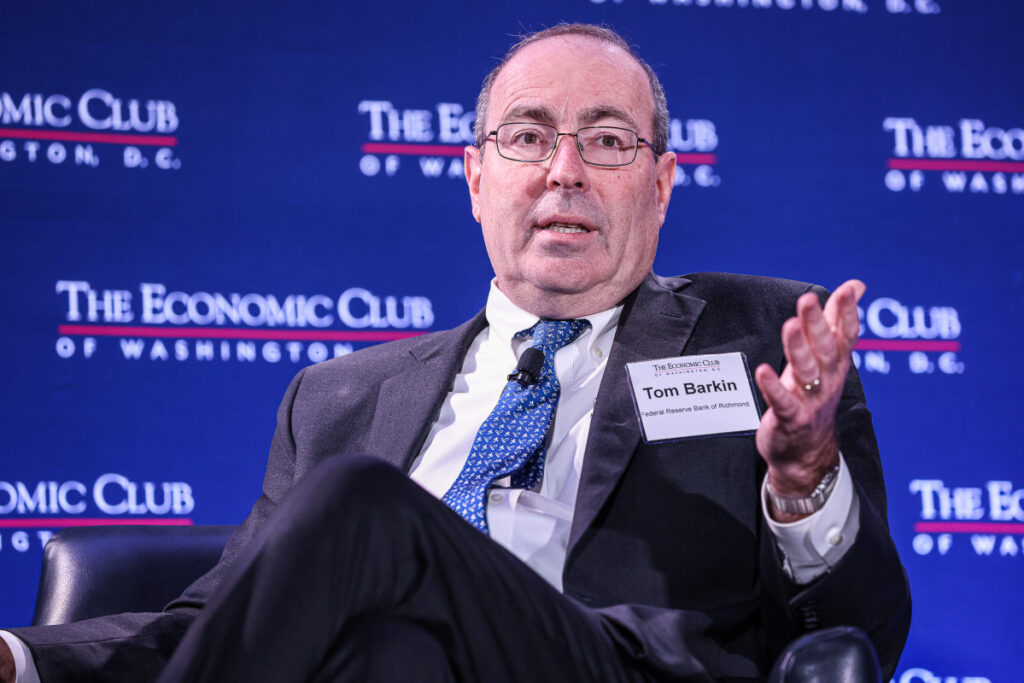
The presidents of the 12 Federal Reserve banks see the economy differently than the seven Federal Reserve governors and the big staff who work from Washington, D.C.
It’s only natural. Their jobs are different. Fed bank presidents focus first on their districts, not the entire United States.
🎁 Buy 1 Year and Get 1 Year FREE on TheStreet Pro. Act now before it’s gone ⏰
Consider Tom Barkin, president of the Federal Reserve Bank of Richmond. The bank’s district covers most of West Virginia, and all of Maryland, the District of Columbia, Virginia, North Carolina and South Carolina.
Related: Goldman Sachs picks top sectors to own in 2025
For the most part, Barkin said in a Friday speech to the Maryland Bankers Association, the economies both in his district and the United States are in decent shape.
He expects more growth in 2025 overall, but he is concerned about inflation pressures that won’t give up.
Why the economy has been so strong
The national economy did well in 2024 (and 2023 before it) because of some surprising conditions at work:
Consumer spending overall was consistent and strong. Already the U.S. economy has recovered from health and economic shocks of the Covid-19 pandemic, he argued. The rebound was much stronger and faster than a traditional economic recession.
The labor market was strong once the pandemic eased, and it still is. Employers, he reported, “don’t want to get caught short workers again. As a result, while cautious employers are allowing headcount to drift downward through attrition and reduced hiring, they are slow to reduce staff.”
Increasing price sensitivity. Consumers, in particular, “are trading down from beef to chicken, from sit-down restaurants to fast casual, from brand names to private labels. They’re waiting for promotions or moving to lower-priced outlets.” Three big winners in that scenario, though Barkin didn’t name names, would be Walmart (WMT) , Costco Wholesale (COST) and, of course, Amazon.com (AMZN) .
Increasing productivity. Between 2010 and 2020, U.S. productivity ran at a 1.2% annualized rate. In the current decade, the rate has jumped to 2.3%. That’s partly due to investments in automation and more efficient processes, said the former McKinsey & Co. consultant. Plus, as labor markets have been less stretched, turnover rates have slowed, and experienced workers get more done than new hires.
JEFF KOWALSKY/Getty Images
Pressures could derail the progress
Barkin offered up an appealing scenario, one shared by Wall Street, large swaths of business owners and managers across the country and, of course, the incoming Trump administration.
He did note some risks — perhaps only concerns.
More Economic Analysis:
- US stocks rule as bull market bets highlight ‘American exceptionalism’
- Veteran analyst who predicted the S&P 500’s rally unveils target for 2025
- Trump’s plans will test Fed interest rate cut bets in 2025
Inflation. “Inflation is not yet back to target, so we still have more work to do,” he told his audience. But the worst of the inflation that erupted after the pandemic has eased. So if interest rates won’t be coming down as fast as some hope in the next year, it would take a big shock to force them higher.
Post-election uncertainty. Marina Azzimonti, an economist at the Richmond Fed, has been studying policy uncertainty around elections. Her research suggests uncertainty doesn’t end when the election ends, Barkin said. You won’t know how the victors will operate until they get into office. And it may take time after that. Take tariffs. “what tariff rates will actually be imposed?” Barkin asked, “On what countries? On which products? For how long? Will there be retaliation?” Those are only a few of the questions that need consideration.
Post-election uncertainty for local economies. Elon Musk and Vivek Ramaswamy have vowed to cut $2 trillion in federal spending. There are few details on this, and even Barkin warned his audience on Friday to be watchful. The District of Columbia is in the Richmond Fed’s district, and the district, Virginia, Maryland and even West Virginia count residents who work for the federal government. Big layoffs in communities with substantial government investments will hurt local economies.
If Barkin left anything out in his remarks, it was the uncertainty about the massive power demands that data centers will be generating to handle artificial intelligence computing tasks. Virginia is seeing strong demand for power to data centers and strong demand for land to build on.
Related: Veteran fund manager issues dire S&P 500 warning for 2025


